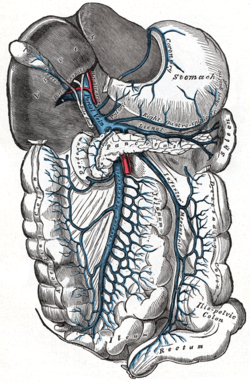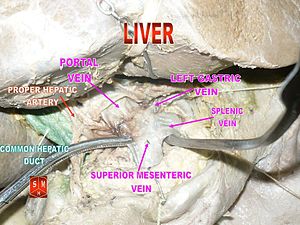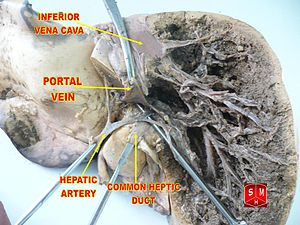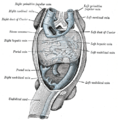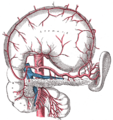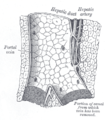- Hepatic portal vein
-
Vein: Hepatic portal vein The portal vein and its tributaries. It is formed by the superior mesenteric vein and splenic vein. Leinal vein is an old term for splenic vein. Latin vena portae hepatis Gray's subject #174 681 Drains from Gastrointestinal tract, spleen, pancreas Source splenic vein, superior mesenteric vein Drains to liver sinusoid MeSH Portal+Vein - This page is the redirect for portal vein. For a vein that connects two systems of capillary beds see portal venous system.
The hepatic portal vein is not a true vein, because it does not conduct blood directly to the heart. It is a vessel in the abdominal cavity that drains blood from the gastrointestinal tract and spleen to capillary beds in the liver. It is usually formed by the confluence of the superior mesenteric and splenic veins and also receives blood from the inferior mesenteric, gastric, and cystic veins. The hepatic portal vein is a major component of the hepatic portal system, and it is one of only two portal venous systems in the body. The other is the hypophyseal portal system.
Conditions involving the hepatic portal vein cause considerable illness and death. An important example of such a condition is elevated blood pressure in the hepatic portal vein. This condition, called portal hypertension, is a major complication of cirrhosis.
Contents
Anatomy
Tributaries of the hepatic portal vein[1] Measuring approximately 8 cm (3 inches) in adults,[2] the hepatic portal vein is located in the right upper quadrant of the abdomen, originating behind the neck of the pancreas.[3]
In most individuals, the hepatic portal vein is formed by the union of the superior mesenteric vein and the splenic vein.[4] For this reason, the hepatic portal vein is occasionally called the splenic-mesenteric confluence.[3] Occasionally, the hepatic portal vein also directly communicates with the inferior mesenteric vein, although this is highly variable. Other tributaries of the hepatic portal vein include the cystic and gastric veins.[1]
Immediately before reaching the liver, the portal vein divides into right and left. It ramifies further, forming smaller venous branches and ultimately portal venules. Each portal venule courses alongside a hepatic arteriole and the two vessels form the vascular components of the portal triad. These vessels ultimately empty into the hepatic sinusoids to supply blood to the liver.[1]
Portacaval anastomoses
The portal venous system has several anastomoses with the systemic venous system. In cases of portal hypertension these anastamoses may become engorged, dilated, or varicosed and subsequently rupture.
Accessory hepatic portal veins
Accessory hepatic portal veins are those veins that drain directly into the liver without joining the hepatic portal vein. These include the paraumbilical veins as well as veins of the lesser omentum, falciform ligament, and those draining the gallbladder wall.[3]
Physiology
The hepatic portal vein and hepatic arteries form the liver's dual blood supply. Approximately 75% of hepatic blood flow is derived from the hepatic portal vein, while the remainder is from the hepatic arteries.[3]
Unlike most veins, the hepatic portal vein does not drain into the heart. Rather, it is part of a portal venous system that delivers venous blood into another capillary system, namely the hepatic sinusoids of the liver. In carrying venous blood from the gastrointestinal tract to the liver, the hepatic portal vein accomplishes two tasks; namely, it supplies the liver with metabolic substrates and it ensures that substances ingested are first processed by the liver before reaching the systemic circulation. After draining into the liver sinusoids, blood from the liver is drained by the hepatic vein.
Role in disease
Portal hypertension
Main article: Portal hypertensionIncreased blood pressure in the portal vein, called portal hypertension, is a major complication of liver disease, most commonly cirrhosis.[5] Stigmata of portal hypertension include those of chronic liver disease: ascites, esophageal varices, spider nevi, caput medusae, and palmar erythema.[6]
Pylephlebitis
Main article: PylephlebitisPylephlebitis is infection of the hepatic portal vein, usually arising from an infectious intraabdominal process such as diverticulosis.[7][8]
References
- ^ a b c Henry Gray (1901). Anatomy, Descriptive and Surgical (16 ed.). Philadelphia: Lea Brothers. pp. 619.
- ^ Harold M Chung; Chung, Kyung Won (2008). Gross anatomy. Philadelphia: Wolters Kluwer Health/Lippincott Williams & Wilkins. pp. 208. ISBN 0-7817-7174-9.
- ^ a b c d Plinio Rossi; L. Broglia (2000). Portal Hypertension: Diagnostic Imaging and Imaging-Guided Therapy. Berlin: Springer. pp. 51. ISBN 3-540-65797-5.
- ^ Benjamin L. Shneider; Sherman, Philip M. (2008). Pediatric Gastrointestinal Disease. Connecticut: PMPH-USA. pp. 751. ISBN 1-55009-364-9.
- ^ Dooley, James; Sherlock, Sheila (2002). Diseases of the liver and biliary system. Oxford: Blackwell Science. ISBN 0-632-05582-0.
- ^ Key Topics in General Surgery (2 ed.). Informa Healthcare. 2002. ISBN 1-85996-164-9.
- ^ Plemmons RM, Dooley DP, Longfield RN (November 1995). "Septic thrombophlebitis of the portal vein (pylephlebitis): diagnosis and management in the modern era". Clin. Infect. Dis. 21 (5): 1114–20. doi:10.1093/clinids/21.5.1114. PMID 8589130.
- ^ Perez-Cruet MJ, Grable E, Drapkin MS, Jablons DM, Cano G (May 1993). "Pylephlebitis associated with diverticulitis". South. Med. J. 86 (5): 578–80. doi:10.1097/00007611-199305000-00020. PMID 8488411. http://meta.wkhealth.com/pt/pt-core/template-journal/lwwgateway/media/landingpage.htm?issn=0038-4348&volume=86&issue=5&spage=578.
Additional images
-
Section across portal triad of pig.
External links
- SUNY Labs 38:12-0109 - "Stomach, Spleen and Liver: The Visceral Surface of the Liver"
- SUNY Anatomy Image 7959
- SUNY Anatomy Image 8565
- SUNY Anatomy Image 8697
- Cross section at UV pembody/body8a
- Human anatomy at Dartmouth figures/chapter_30/30-2.HTM
Circulatory system: Arteries and veins (TA A12.0, TH H3.09.02, GA 6.543/GA 7.641) Systemic circulation (Left heart) → Aorta → Arteries → Arterioles → Capillaries → Venules → Veins → Vena cava → (Right heart)Pulmonary circulation Blood vessels Arteries Veins Lymphatic Veins of the abdomen and pelvis (TA A12.3.09–10, 12, GA 7.672) To azygos system IVC
(Systemic)To IVC or left renal veininferior phrenic · hepatic (central veins of liver, liver sinusoid) · suprarenal · renal · gonadal (ovarian ♀/testicular ♂, pampiniform plexus ♂) · lumbar · common iliacUnpairedposterior: iliolumbar · superior gluteal · lateral sacral
anterior: inferior gluteal · obturator · uterine ♀ (uterine plexus ♀) · vesical (vesical plexus, prostatic plexus ♂, deep of penis ♂/clitoris ♀, posterior scrotal ♂/labial ♀) · vaginal plexus/vein ♀ · middle rectal · internal pudendal (inferior rectal, bulb of penis ♂/vestibule ♀) · rectal plexusPortal vein
(Portal)DirectCategories:- Veins of the torso
Wikimedia Foundation. 2010.

